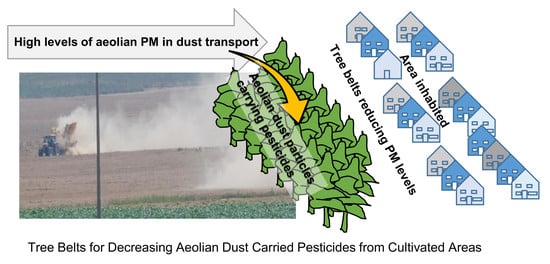Tree Belts for Decreasing Aeolian Dust-Carried Pesticides from Cultivated Areas
Abstract
:1. Introduction
2. Materials and Methods
2.1. Study Area
2.2. Data Collection
2.3. Aeolian Particle Analysis
2.4. Statistics
3. Results
4. Discussion
5. Conclusions
Author Contributions
Funding
Acknowledgments
Conflicts of Interest
Appendix A
| Site and Season | Location | Average Amount of Dust per Month (g m−2) | Pesticide | Amount of Pesticide per Month (μg m−²) |
|---|---|---|---|---|
| Asaf/Autumn | Field | 1.8 | ND * | ND |
| Asaf/Autumn | 1 | 12.2 | ND | ND |
| Asaf/Autumn | 2 | 7.1 | ND | ND |
| Asaf/Autumn | Field | 48.2 | Chlorothalonil | 0.293 |
| Asaf/Autumn | 1 | 8.7 | Diphenylamine | 0.021 |
| Asaf/Winter | 1 | 8.7 | Chlorothalonil | 0.072 |
| Asaf/Winter | 2 | 33.2 | Chlorothalonil | 4.417 |
| Asaf/Winter | 2 | 33.2 | Endosulfan | 1.174 |
| Asaf/Spring | Field | 16.4 | Chlorothalonil | 0.045 |
| Asaf/Spring | 1 | 9.7 | Endosulfan | 0.064 |
| Asaf/Spring | 2 | 15.5 | Chlorothalonil | 0.465 |
| Dorot/Autumn | Field | 7.7 | ND | ND |
| Dorot/Autumn | 1 | 6 | ND | ND |
| Dorot/Autumn | 2 | 7.2 | ND | ND |
| Dorot/Winter | Field | 3.8 | Diazinon | 0.023 |
| Dorot/Winter | Field | 3.8 | Chlorthal-dimethyl | 0.004 |
| Dorot/Winter | 1 | 2.3 | Endosulfan | 0.388 |
| Dorot/Winter | 2 | 0.3 | ND | ND |
| Site and Season | Location | Average Amount of Dust per Month (g m−2) | Pesticide | Amount of Pesticide per Month(μg m−²) |
|---|---|---|---|---|
| Dorot/Spring | Field | 4.2 | Bifenthrin | 0.017 |
| Dorot/Spring | Field | 4.2 | Diuron | 0.023 |
| Dorot/Spring | 1 | 3.6 | Novaluron | 0.027 |
| Dorot/Spring | 1 | 3.6 | Diuron | 0.008 |
| Dorot/Spring | 1 | 3.6 | Chlorothalonil | 0.26 |
| Dorot/Spring | 1 | 3.6 | Endosulfan | 0.053 |
| Dorot/Spring | 2 | 4.2 | Novaluron | 0.014 |
| Dorot/Spring | 2 | 4.2 | Diuron | 0.019 |
| Dorot/Spring | 2 | 4.2 | Chlorothalonil | 0.465 |
| Shmarya/Autumn | Field | 10.3 | ND * | ND |
| Shmarya/Autumn | 1 | 14.9 | ND | ND |
| Shmarya/Autumn | 2 | 17.7 | ND | ND |
| Shmarya/Winter | Field | 26.8 | Diuron | 0.03 |
| Shmarya/Winter | 1 | 4 | ND | ND |
| Shmarya/Winter | 2 | 11.2 | Chlorthal-dimethyl | 0.085 |
| Shmarya/Winter | 2 | 11.2 | Diuron | 0.066 |
| Shmarya/Winter | 2 | 11.2 | Chlorothalonil | 0.294 |
| Shmarya/Spring | Field | 7.3 | ND | ND |
| Shmarya/Spring | 1 | 30.4 | Chlorothalonil | 0.584 |
| Shmarya/Spring | 1 | 30.4 | Diuron | 0.034 |
| Shmarya/Spring | 2 | 25.4 | Diuron | 0.041 |
| Shmarya/Spring | 2 | 25.4 | Chlorothalonil | 1.805 |
| Shmarya/Spring | 2 | 25.4 | Endosulfan | 2.297 |
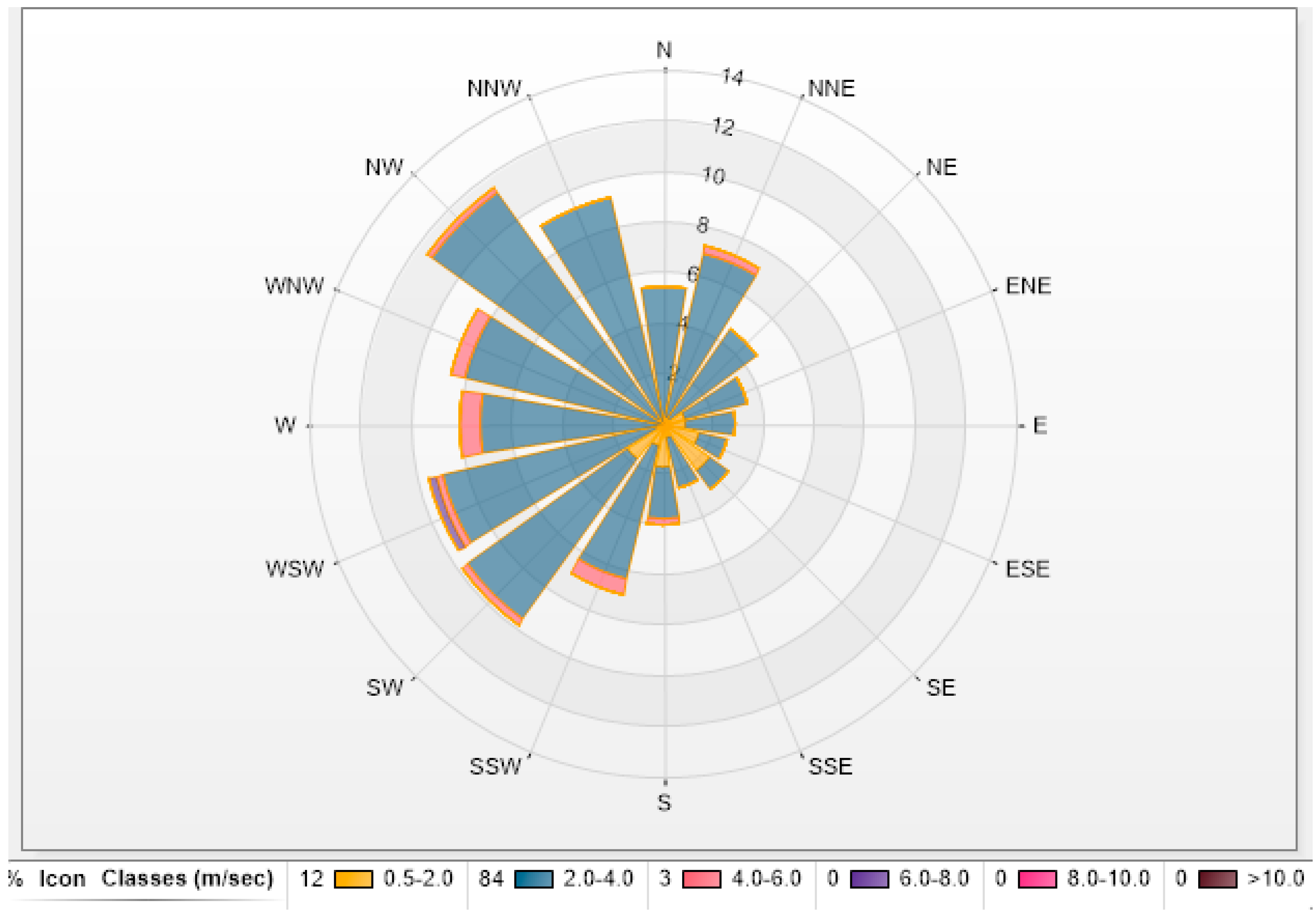
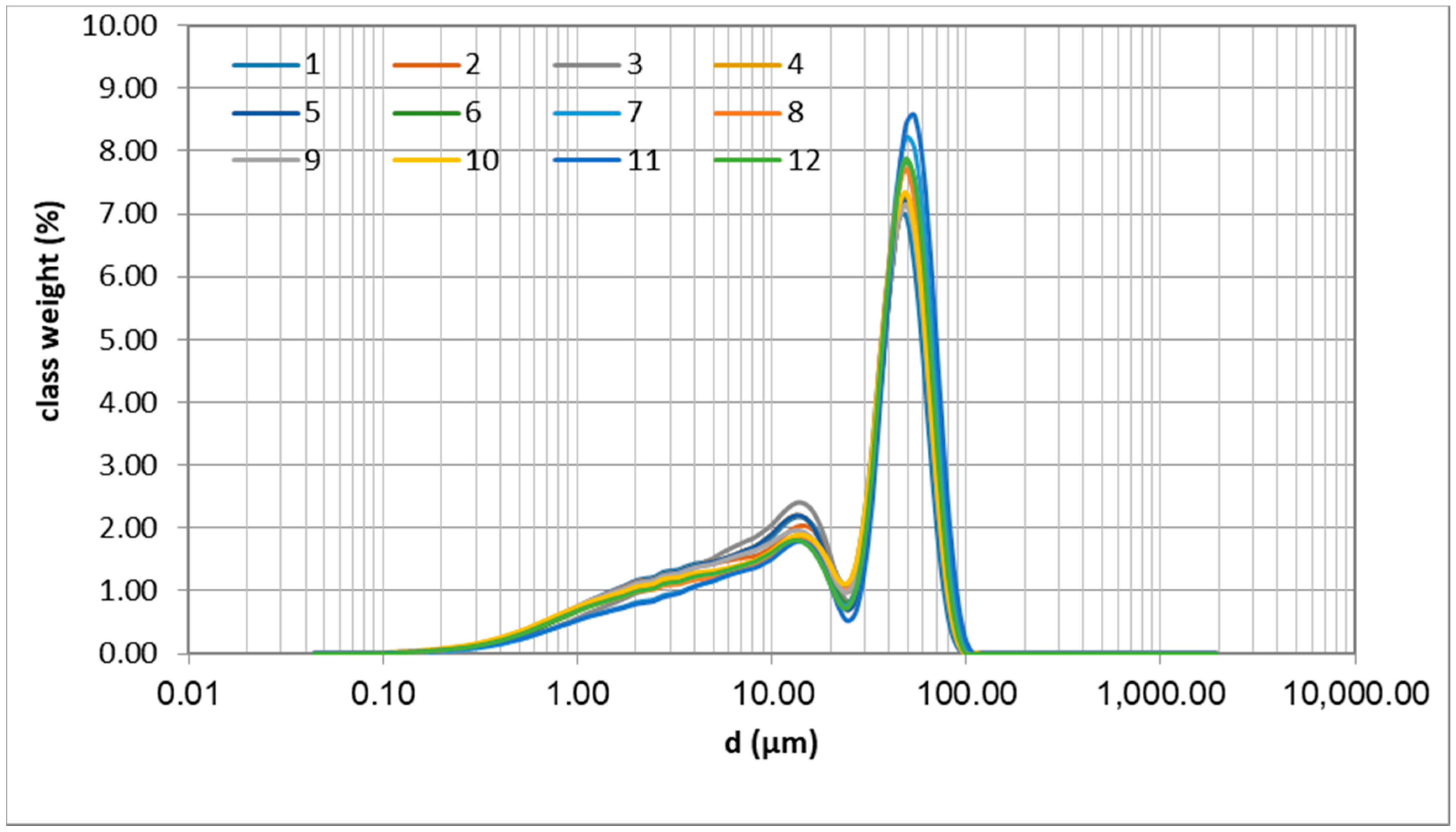
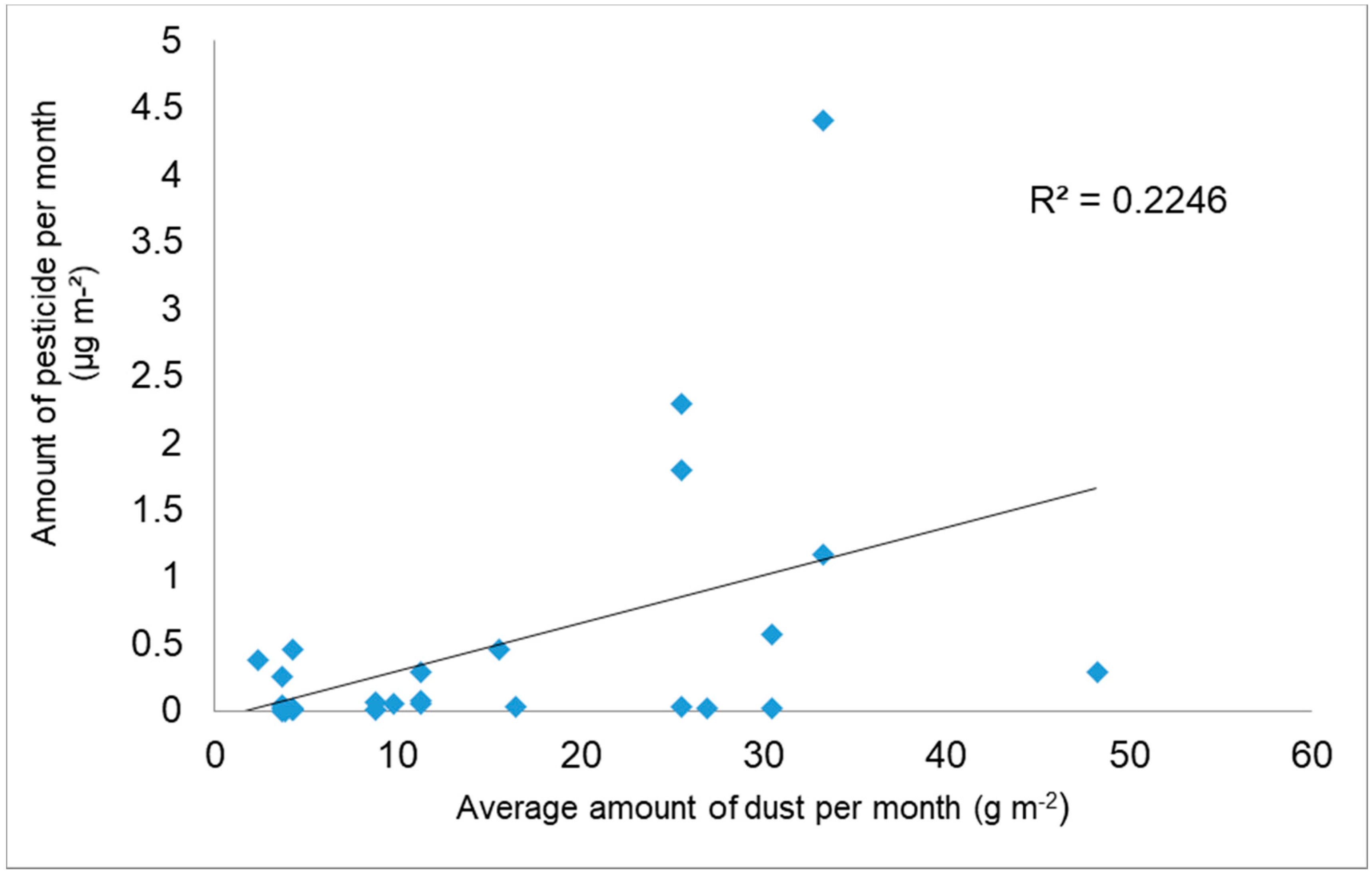
References
- Van der Werf, H.M.G. Assessing the impact of pesticides on the environment. Agric. Ecosyst. Environ. 1996, 60, 81–96. [Google Scholar] [CrossRef]
- Alavanja, M.C.R. Pesticides use and exposure extensive worldwide. Rev. Environ. Health 2009, 24, 303–309. [Google Scholar] [CrossRef] [PubMed]
- Carson, R. Silent Spring; Riverside Press: Cambridge, MA, USA, 1962. [Google Scholar]
- Severn, D.J.; Ballard, G. Risk/benefit and regulations. In Pesticides in the Soil Environment: Processes, Impacts and Modeling; Book Series No. 2; Soil Science Society of America: Madison, WI, USA, 1990; pp. 467–491. [Google Scholar]
- Emans, H.J.B.; Beek, M.A.; Linders, J.B.H.J. Evaluation System for Pesticides (ESPE) I. Agricultural Pesticide; Rep. No. 679101004; National Institute of Public Health and Environmental Protection (RIVM): Bilthoven, The Netherlands, 1992. [Google Scholar]
- European Commission. EU Pesticides Database. Available online: http://ec.europa.eu/food/plant/pesticides/eu-pesticides-database/public/?event=homepage&language=EN (accessed on 7 April 2016).
- Taylor, A.W.; Spencer, W.F. Volatilization and vapor transport processes. In Pesticides in the Soil Environment: Processes, Impacts and Modeling; Book Series No. 2; Soil Science Society of America: Madison, WI, USA, 1990; pp. 213–269. [Google Scholar]
- Ucar, A.; Hall, F.R. Windbreaks as a pesticide drift mitigation strategy: A review. Pest Manag. Sci. 2001, 57, 663–675. [Google Scholar] [CrossRef] [PubMed]
- Young, S.L. Natural Product Herbicides for Control of Annual Vegetation Along Roadsides. Weed Technol. 2004, 18, 580–587. [Google Scholar] [CrossRef]
- Arias-Estevez, M.; López-Periago, E.; Martínez-Carballo, E.; Simal-Gandara, J.; Mejuto, J.C.; Garcıa-Rıo, L. The mobility and degradation of pesticides in soils and the pollution of groundwater resources. Agric. Ecosyst. Environ. 2009, 123, 247–260. [Google Scholar] [CrossRef]
- Pimentel, D. Amounts of pesticides reaching target pests: Environmental impacts and ethics. J. Agric. Environ. Ethics 1995, 8, 17–29. [Google Scholar] [CrossRef]
- Schomburg, C.J.; Glotfelty, D.E. Pesticide occurrence and distribution in fog collected near Monterey, California. Environ. Sci. Technol. 1991, 25, 155–160. [Google Scholar] [CrossRef]
- Gregor, D.J.; Gummer, W.D. Evidence of atmospheric transport and deposition of organochlorine pesticides and polychlorinated biphenyls in Canadian arctic snow. Environ. Sci. Technol. 1989, 23, 561–565. [Google Scholar] [CrossRef]
- Walker, A. Simulation of herbicide persistence in soil. Pestic. Sci. 1976, 7, 41–49. [Google Scholar] [CrossRef]
- Atlas, E.L.; Schauffler, S. Concentration and variation of trace organic compounds in the north pacific atmosphere. In Long Range Transport of Pesticides; Kurtz, D.A., Ed.; Lewis Publishers: Chelsea, MI, USA, 1990; pp. 161–183. [Google Scholar]
- Leonard, R.A. Movement of pesticides into surface waters. In Pesticides in the Soil Environment: Processes, Impacts and Modeling; Book Series No. 2; Soil Science Society of America: Madison, WI, USA, 1990; pp. 303–349. [Google Scholar]
- Paterson, S.; MacKay, D.; Tam, D.; Shiu, W.Y. Uptake of organic chemicals by plants: A review of processes, correlations and model. Chemosphere 1990, 21, 297–331. [Google Scholar] [CrossRef]
- Environmental Protection Agency of U.S. (EPA)—Drift Reduction Technology Program. Available online: https://www.epa.gov/reducing-pesticide-drift/about-drift-reduction-technology-program (accessed on 7 July 2017).
- Hall, F.R.; Fox, R. The reduction of pesticide drift. In Pesticide Formulation and Adjuvant Technology, 1st ed.; Foy, C.L., Pritchard, D.W., Eds.; CRC Press: London. UK, 1996; pp. 209–239. [Google Scholar]
- Muscutt, A.D.; Harris, G.L.; Baily, S.W.; Davies, D.B. Buffer zones to improve water quality: A review of their potential use in UK agriculture. Agric. Ecosyst. Environ. 1993, 45, 59–77. [Google Scholar] [CrossRef]
- Reichenberger, S.; Bach, M.; Skitschak, A.; Frede, H.G. Mitigation strategies to reduce pesticide inputs into ground and surface water and their effectiveness: A review. Sci. Total Environ. 2007, 384, 1–35. [Google Scholar] [CrossRef] [PubMed]
- Sabbagh, G.J.; Muñoz-Carpena, R.; Fox, G.A. Distinct influence of filter strips on acute and chronic pesticide aquatic environmental exposure assessments across U.S. EPA scenarios. Chemosphere 2013, 90, 195–202. [Google Scholar] [CrossRef] [PubMed]
- Popov, V.H.; Cornish, P.S.; Sun, H. Vegetated biofilters: The relative importance of infiltration and adsorption in reducing loads of water-soluble herbicides in agricultural runoff. Agric. Ecosyst. Environ. 2005, 114, 351–359. [Google Scholar] [CrossRef]
- Jaeken, P.; Debaer, C. Risk of water contamination by plant protection products (PPP) during pre- and post-treatment operations. Annu. Rev. Agric. Eng. 2005, 4, 93–114. [Google Scholar]
- Vanderstraeten, P.; Lénelle, Y.; Meurrens, A.; Carati, D.; Brenig, L.; Offer, Z.Y.; Zaady, E. Micromorphology and Chemistry of airborne particles during agriculture working periods in Brussels surrounding region. Environ. Monit. Assess. 2007, 146, 33–39. [Google Scholar] [CrossRef] [PubMed]
- Makarov, V.I.; Ankilov, A.N.; Koutsenogii, K.P.; Borodulin, A.I.; Samsonov, Y.N. Efficiency of the inertial wind capture of pesticide aerosols by vegetation species. J. Aerosol Sci. 1996, 27, 67–68. [Google Scholar] [CrossRef]
- Tyndall, J.; Colletti, J. Mitigating swine odor with strategically designed shelterbelt systems: A review. Agrofor. Syst. 2006, 69, 45–65. [Google Scholar] [CrossRef]
- Grala, R.K.; Tyndall, J.C.; Mize, C.W. Impact of field windbreaks on visual appearance of agricultural lands. Agrofor. Syst. 2010, 80, 411–422. [Google Scholar] [CrossRef]
- Reimer, A.P.; Prokopy, L.S. Environmental attitudes and drift reduction behavior among commercial pesticide applicators in a U.S. agricultural landscape. J. Environ. Manag. 2012, 113, 361–369. [Google Scholar] [CrossRef] [PubMed]
- Vanella, G.; Salyani, M.; Balsari, P. Spray interactions with a windbreak netting used in orchard applications. Crop Protect. 2013, 44, 95–103. [Google Scholar] [CrossRef]
- Bouvet, T.; Loubet, B.; Wilson, J.D.; Tuzet, A. Filtering of windborne particles by a natural windbreak. Boundary-Layer Meteo. 2007, 123, 481–509. [Google Scholar] [CrossRef]
- Uni, D.; Katra, I. Airborne dust absorption by semi-arid forests reduces PM pollution in nearby urban environments. Sci. Total Environ. 2017, 598, 984–992. [Google Scholar] [CrossRef] [PubMed]
- Richards, J.; Reif, R.; Luoc, Y.; Gana, J. Distribution of pesticides in dust particles in urban environments. Environ. Pollut. 2016, 214, 290–298. [Google Scholar] [CrossRef] [PubMed]
- Israel Meteorological Service. Available online: http://www.ims.gov.il/IMSENG/All_Tahazit/homepage.htm (accessed on 13 July 2018).
- Offer, Z.; Zaady, E.; Shachak, M. Aeolian particles input to soil surface at the northern limit of the Negev desert. Arid Land Res. Manag. 1998, 12, 55–62. [Google Scholar] [CrossRef]
- Zaady, E.; Offer, Y.Z.; Shachak, M. The content and contribution of the accumulated aeolian organic matter in a dry ecosystem. Atmos. Environ. 2001, 35, 769–776. [Google Scholar] [CrossRef]
- Tanner, S.; Katra, I.; Haim, A.; Zaady, E. Quantification of short-term soil loss by aeolian erosion in response to conventional and organic agricultural practices. Soil Tillage Res. 2016, 155, 149–156. [Google Scholar] [CrossRef]
- Martel, A.C.; Lair, C. Validation of a highly sensitive method for the determination of neonicotinoid insecticides residues in honeybees by liquid chromatography with electrospray tandem mass spectrometry. Int. J. Environ. Anal. Chem. 2011, 91, 978–988. [Google Scholar] [CrossRef]
- Eiserbeck, C.; Nelson, R.K.; Grice, K.; Curiale, J.; Reddy, C.M. Comparison of GC–MS, GC–MRM–MS, and GC×GC to characterise higher plant biomarkers in Tertiary oils and rock extracts. Geochim. Cosmochim. Acta 2012, 87, 299–322. [Google Scholar] [CrossRef]
- Simcox, N.J.; Fenske, R.A.; Wolz, S.A.; Chwen Lee, I.; Kalman, D.A. Pesticides in household dust and soil: Exposure pathways for children of agriculture families. Environ. Health Perspect. 1995, 103, 1126–1134. [Google Scholar] [CrossRef] [PubMed]
- Kok, J.F.; Parteli, E.J.R.; Michaels, T.I.; Karam, D.B. The physics of wind-blown sand and dust. Rep. Prog. Phys. 2012, 75, 106901. [Google Scholar] [CrossRef] [PubMed]
- Swet, N.; Katra, I. Reduction in soil aggregation in response to dust emission processes. Geomorphology 2016, 268, 177–183. [Google Scholar] [CrossRef]
- Bollen, W.B. Interactions between pesticides and soil microorganisms. Annu. Rev. Microbiol. 1961, 15, 69–92. [Google Scholar] [CrossRef]
- Audus, L.J. Herbicide behaviour in the soil. II Interactions with soil microorganisms. In The Physiology and Biochemistry of Herbicides; Audus, L.J., Ed.; Academic Press: New York, NY, USA, 1964; pp. 163–206. [Google Scholar]
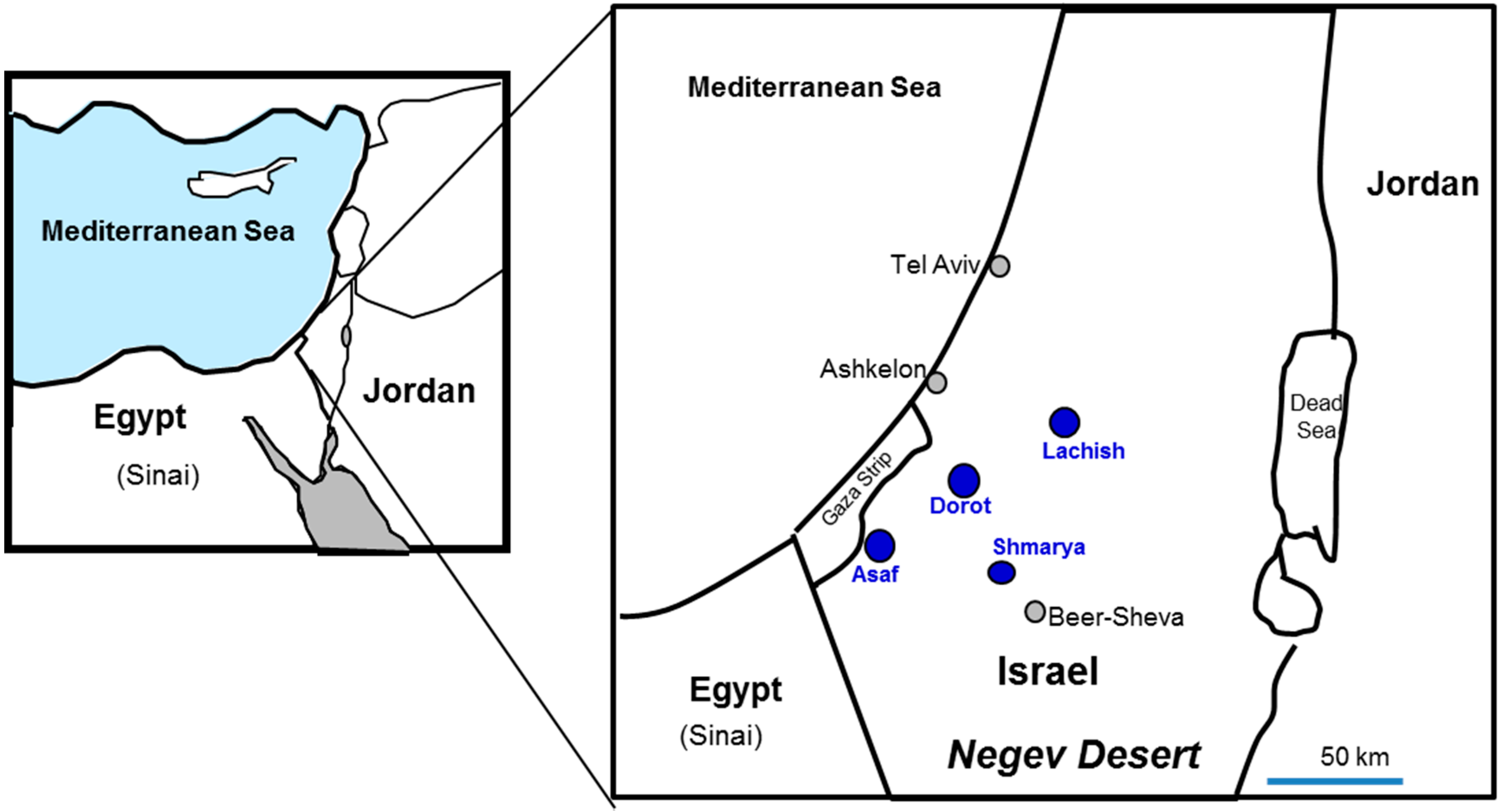
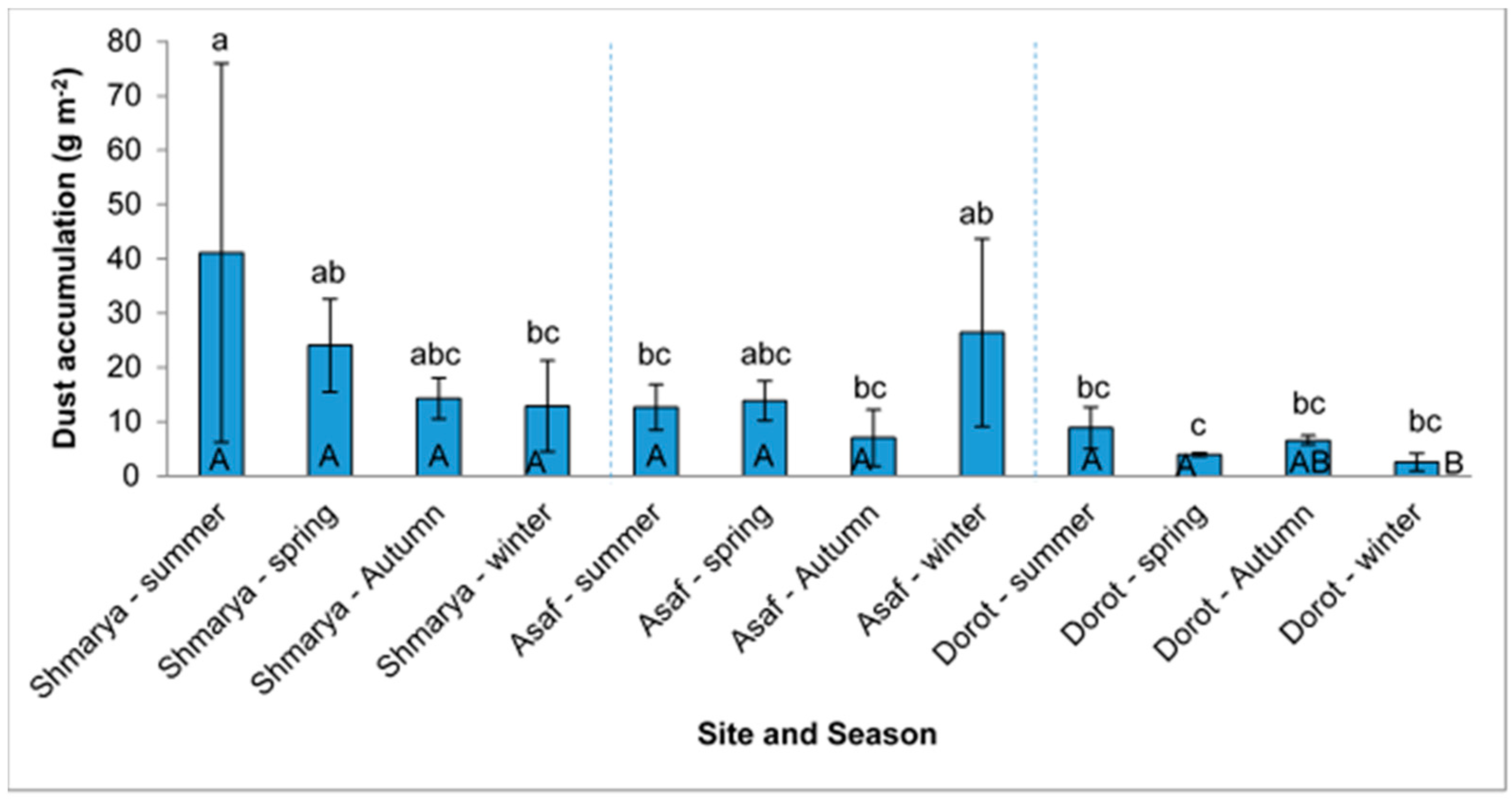
| Site | Location (Longitude, Latitude) | Soil Textural Class [USDA Textural Classes] | Soil Granulometry | Crops | Tree Species | Tree Data |
|---|---|---|---|---|---|---|
| Assaf | 31°20′59″ N; 34°26′3″ E | Sandy clay loam | 23.8% clay, 67.5% sand, 8.8% silt | Peanuts, potatoes, carrots | Pinus halepensis | 10–15 m high and 8–10 m wide |
| Dorot | 31°30′35″ N; 34°39′24″ E | Sandy clay loam | Wheat, potatoes | Eucalyptus camaldulensis | 15–20 m high and 5–7 m wide | |
| Shmarya | 31°20′31″ N; 34°37′47.5″ E | Sandy clay | 49.2% clay, 37.5% sand, 13.3% silt | Wheat, barley and potatoes | Eucalyptus camaldulensis | |
| Lachish | 31°33′57.4″ N; 34°49′30.2″ E | Sandy clay | Almond groves, orchards, vineyards | Ceratonia siliqua | 10–15 m high and 10–15 m wide |
| Sample | 1 | 2 | 3 | 4 | 5 | 6 | 7 | 8 | 9 | 10 | 11 | 12 |
|---|---|---|---|---|---|---|---|---|---|---|---|---|
| A. Parameters (%) | ||||||||||||
| Clay (<2 μm) | 11.72 | 11.86 | 9.07 | 11.47 | 10.59 | 10.87 | 8.76 | 11.51 | 12.20 | 12.06 | 8.46 | 11.26 |
| Silt (2–63 μm) | 83.22 | 81.27 | 83.68 | 81.59 | 80.01 | 79.91 | 80.13 | 80.80 | 80.92 | 80.98 | 77.89 | 80.07 |
| Sand (>63 μm) | 5.06 | 6.87 | 7.25 | 6.94 | 9.38 | 9.22 | 11.11 | 7.68 | 6.88 | 6.96 | 13.65 | 8.66 |
| B. Size fractions (%) | ||||||||||||
| PM20 | 49.00 | 47.60 | 47.88 | 48.97 | 41.97 | 42.74 | 38.69 | 43.35 | 47.59 | 45.35 | 37.64 | 43.23 |
| PM10 | 35.14 | 34.51 | 32.64 | 35.08 | 31.06 | 30.95 | 27.29 | 31.32 | 35.00 | 33.13 | 26.42 | 31.79 |
| PM2.5 | 14.39 | 14.49 | 11.32 | 14.10 | 12.94 | 13.19 | 10.68 | 13.80 | 14.77 | 14.50 | 10.28 | 13.57 |
| PM ≤ 1.0 | 5.05 | 5.23 | 3.76 | 4.91 | 4.77 | 4.98 | 3.98 | 5.53 | 5.65 | 5.77 | 3.88 | 5.32 |
| Pesticide | Group | Application |
|---|---|---|
| Bifenthrin | Pyrethroid | Insecticide against pests of cotton, vegetables and flowers |
| Carfentrazone-ethyl | Triazolinone | Herbicide against broad-leaved weeds in cereal crops |
| Chlorpyrifos | Organophosphate | Insecticide for vegetables, orchards and vineyards |
| Chlorthal-dimethyl- | Chloro-benzen | Pre-emergence herbicide for grass and common weeds |
| Chlorothalonil | Organochlorine | Insecticide against mites for citrus orchards, field crops, vegetable and flowers |
| Cyprodinil | Pyrimidine | Fungicide for orchards and vineyards |
| Diazinon | Organophosphate | Insecticide against pests of field crops, orchards and flowers |
| Diflufenican | Phenoxy | Herbicide applied in orchards and vineyards |
| Diphenylamine | Phenylaniline | Fungicide for citrus and other orchards |
| Diuron | Substituted Urea | Herbicide for orchards and field crops |
| Endosulfan | Organochlorine | Insecticide against pests in deciduous orchards |
| Folpet | Thiophtalimide | Fungicide for control of mildew in vineyards and field crops |
| Novaluron | Benzoylurea | Insecticide for cotton and potatoes |
| Oxyfluorfen | Diphenyl Ether | General herbicide for orchards, flowers and field crops |
| Penconazole | Azole | Fungicide for orchards, vegetables and flowers |
| Pirimicarb | Carbamate | Insecticide for vegetables and field crops |
| Pyrimethanil | Pyrimidine | Mold fungicide for vineyards, flowers and field crops |
| Trifloxystrobin | Strobin | Fungicide for mildew in orchards and vegetables |
| Site and Season | Location | Monthly Aeolian Dust Particle Accumulation (g m−2) | Pesticide | Pesticide per Month (μg m−²) |
|---|---|---|---|---|
| Lachish/winter | Field near C. siliqua | 55.4 | Bifenthrin | 1.57 |
| Lachish/spring | Field near C. siliqua | 58.2 | Oxyfluorfen | 240.93 |
| Lachish/spring | Field near C. siliqua | 58.2 | Trifloxystrobin | 8.34 |
| Lachish/summer | Field near C. siliqua | 22.3 | Bifenthrin | 3.98 |
| Lachish/summer | Field near P. halepensis | 8 | Bifenthrin | 9.6 |
| Lachish/summer | 1-near C. siliqua | 8.2 | Bifenthrin | 0.73 |
| Lachish/summer | 1-near C. siliqua | 8.2 | Diphenylamine | 2.3 |
| Lachish/summer | Field near P. halepensis | 8 | Folpet | 16.21 |
| Site | Location | Horizon * | Pesticide | Amount of Pesticide (μg kg soil−1) |
|---|---|---|---|---|
| Lachish | Field | D | Pyrimethanil | 240.13 |
| Lachish | 1 | A | Diphenylamine | 20.63 |
| Lachish | 1 | B | Bifenthrin | 29.78 |
| Lachish | 1 | D | Bifenthrin | 30.34 |
| Lachish | 2 | B | Diflufenican | 88.54 |
| Lachish | 2 | B | Bifenthrin | 31.5 |
| Lachish | 2 | C | Bifenthrin | 255.1 |
© 2018 by the authors. Licensee MDPI, Basel, Switzerland. This article is an open access article distributed under the terms and conditions of the Creative Commons Attribution (CC BY) license (http://creativecommons.org/licenses/by/4.0/).
Share and Cite
Zaady, E.; Katra, I.; Shuker, S.; Knoll, Y.; Shlomo, S. Tree Belts for Decreasing Aeolian Dust-Carried Pesticides from Cultivated Areas. Geosciences 2018, 8, 286. https://doi.org/10.3390/geosciences8080286
Zaady E, Katra I, Shuker S, Knoll Y, Shlomo S. Tree Belts for Decreasing Aeolian Dust-Carried Pesticides from Cultivated Areas. Geosciences. 2018; 8(8):286. https://doi.org/10.3390/geosciences8080286
Chicago/Turabian StyleZaady, Eli, Itzhak Katra, Shimshon Shuker, Yaakov Knoll, and Sarig Shlomo. 2018. "Tree Belts for Decreasing Aeolian Dust-Carried Pesticides from Cultivated Areas" Geosciences 8, no. 8: 286. https://doi.org/10.3390/geosciences8080286
APA StyleZaady, E., Katra, I., Shuker, S., Knoll, Y., & Shlomo, S. (2018). Tree Belts for Decreasing Aeolian Dust-Carried Pesticides from Cultivated Areas. Geosciences, 8(8), 286. https://doi.org/10.3390/geosciences8080286




